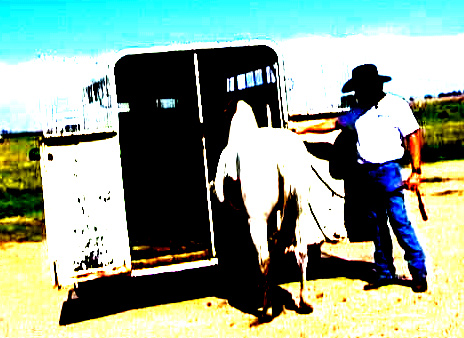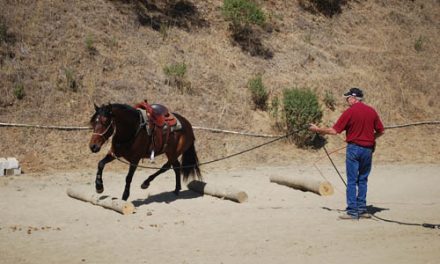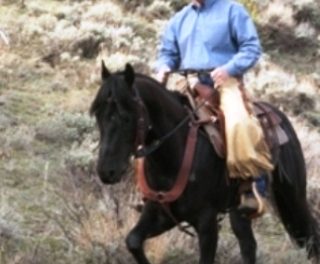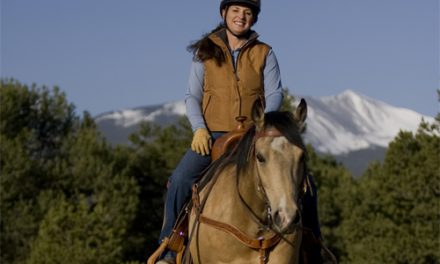 Having a horse that will calmly and safely get in and out of the trailer in any situation is very important. The trailer is a relatively small, enclosed space, where you and your horse can get hurt easily if things go wrong. So it is vitally important that you take the time to work with your horse before you need to go somewhere in the trailer. The day you are trying to get him to the vet for urgent treatment is not the day you want to find out he doesn’t load well.
Having a horse that will calmly and safely get in and out of the trailer in any situation is very important. The trailer is a relatively small, enclosed space, where you and your horse can get hurt easily if things go wrong. So it is vitally important that you take the time to work with your horse before you need to go somewhere in the trailer. The day you are trying to get him to the vet for urgent treatment is not the day you want to find out he doesn’t load well.
I believe trailer loading problems are caused by two things. One is a legitimate fear of the trailer, which is usually caused by a bad experience in the past. The other is a leading problem; if your horse leads properly, he should follow you any where, including into the trailer, without pushing on you or resisting.
Groundwork exercises
For both fear and leading problems, I start with the same groundwork exercises to build trust and to explain to my horse what the lead rope means. I like to use a rope halter for these exercises; that way, there is no hardware or snaps banging on my horse’s head. I highly recommend using an Equiface Saver as well. This protective headgear will keep your horse from getting hurt if he does throw his head up or bump into anything in the trailer. You will also need a light dressage whip for part of this exercise.
Find a safe area away from the trailer as you will want to practice the ground work exercises somewhere without the added pressure of the trailer first. Your horse may already know these basic ground work exercises. But even if he does, you should review them so they are fresh in his mind.
• Move his shoulders away from you. Start by moving your horse’s shoulders away from you as you send him off in a circle around you. Point with one hand, and then, if your horse doesn’t move in the direction in which you pointed, reinforce the cue by swinging the tail of your lead rope. He should step off, moving his shoulders away from you and not in towards you. If he does push his shoulders in to you, step towards him and drive his shoulders away. When you get a step in the right direction, release the pressure and pet him.
• Move his hips. Once you can move his shoulders away, review moving his hips. Ask him to step under himself with the hind leg closest to you, crossing it in front of the outside hind leg. When he has taken as many steps as you wanted, release and reward him.
• Practice the head down cue. This is especially important if you are working with a horse that pulls back in the trailer. Put your hand on the lead rope below where it connects to the halter, and put slight down-ward pressure. Hold the pressure, neither increasing nor decreasing, until your horse lowers his head. Release to reward him, and then ask again. You want to practice this until you can get your horse’s head all the way to the ground.
Now that you have reviewed control of the shoulders, hips, and can put your horse’s head down on cue, you are ready to move to the trailer.
Exercises near the trailer
Bring your horse near the trailer, and review the groundwork exercises you just practiced. This is to remind your horse that nothing has changed. Even though you are in a different location, he still is expected to give you the same responses, and you should give him the same rewards.
Standing near the door
Once you have reviewed the groundwork exercises and your horse is being responsive near the trailer, bring him up to the trailer door. If you are dealing with a young horse who has never loaded before and he gets right in, let him. Then reward him for it.
If you are dealing with an older horse who has some fear issues around the trailer, don’t let him get in. If he does get in, don’t make a big deal of it. Just ask him to come right out again.
If your horse is nervous just standing by the door of the trailer, work with him on the head down cue until he is relaxed. There is no sense in asking him to get in the trailer until he is completely calm; you are just asking for a wreck if you do. He should also stay focused on the inside of the trailer, rather than looking all around.
If your horse backs away, don’t pull on his head. Instead, stand to the side of him and tap his hip with the dressage whip to cue him to move forward. When he does take a step toward the trailer, stop tapping. Periodically back your horse away from the trailer and lead him up to the door again.
Loading-up
• Ask him to load up. Stand outside the trailer door, and point with the hand that holds the lead rope. If he doesn’t go forward, tap his hip with the whip. When he gets in the trailer, follow him in, and pet him while he stands for a little while.
• Back him out. Before he makes the choice to back out, you make the decision and back him out of the trailer. If he does start to go backwards on his own, do not pull on the lead rope to try to stop him. If you do, it is likely that he will just throw his head up in the air and hurt himself, making his impression of the trailer worse. Leave the lead rope slack, stay calm, and as soon as he is out of the trailer ask him to get right back in again.
If you are in a position where you can keep giving him a go forward cue with light taps to the hip as he backs out, do that. Otherwise, don’t make a big deal out of it. Just have him get right back in as soon as he is fully out of the trailer.
• Put him in a trailer stall. Practice putting him in one of the stalls of the trailer and closing the divider. When you open the divider, your horse should stand quietly and wait for your cue to get out of the trailer.
Repeat all the steps outlined in this article hundreds of times until you can get the same response every time you ask and your horse is calmly getting in and out of the trailer.
Ken McNabb grew up on a cattle ranch and is a life-long horseman, as well as a popular trainer and clinician, whose methods are based on his work with John Lyons and his own experiences with horses. Ken is known as being a master communicator who helps both horse and rider become the best they can be. Ken is regularly featured on RFD-TV. Learn more about Ken by visiting www.kenmcnabb.com.





